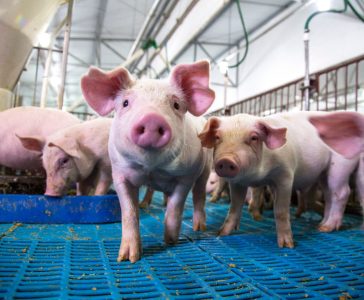In this review, we summarize recent approaches to optimize the availability of P in livestock diets and improve their utilization efficiency.
It has been proven that phased feeding manages to reduce P excretion by 20%. The addition of phytase enzymes to diets increased P availability from 42% to 95%. Low-phytate transgenic plants and transgenic animals increased phosphorus availability by 14% and 52–99%, respectively (Brask-Pedersen et al., 2011).
In practice, a combination of phased feeding and enzyme addition has the greatest potential for P reduction.
On the other hand, functional and nutritional genomics can provide tools to improve efficiency in the future. Phosphorus reserves are finite. Therefore, losses not only cause environmental damage but also represent the waste of a depleted resource. [register]
- This has raised substantial interest towards reducing the phosphorus content of manure applied to agricultural soils, due to concerns regarding pollution and government agencies’ regulations.
Phosphorus is an essential macromineral for all animals, which must be supplied in sufficient quantities as it plays an important role in bone development, growth and the productivity of livestock.
The need to use inorganic P in livestock diets has to do with the fact that the organic P present in some feeds, may not always be completely available for absorption by the animals. (Zhang et al., 200).
- Phosphorus availability
- Feed conversion efficiency
- The amount of consumed P that surpasses the animal’s requirements
There are current opportunities available to help reduce excess P excretion from livestock. These can be divided into two categories:
Matching P requirements of animals with the available P in diets through accurate predictions, feed formulation methods, and feeding animals in groups according to their physiological state, are all tools that contribute to significantly reduce phosphorus excretion.
Cattle can increase their efficiency in P-utilization by incorporating genes that control the production of enzymes which help break down organically bound P and make it available for the animal (Johansen et al., 2003).
Diet formulation strategies to avoid excess phosphorus
Formulating a complete feed in livestock production systems involves determining a combination of ingredients that meets specific nutrient requirements for a target level of production.
- Linear programming is the most widely used optimization tool for formulating livestock diets.
- Traditional, lower-cost formulations seek to minimize the cost of food mixing without considering the environmental consequences of excess P and other nutrients.
Therefore, in a lower cost diet, phosphorus utilization can be optimized through phased feeding. Phased feeding is based on the premise that the population’s P requirements(as well as other essential nutrients) change during growth, lactation and gestation stages.
This reality can be leveraged by feeding multiple diets where each of the diets provides optimal nutrient densities at the midpoint of each subinterval (phase).
Precision feeding with individualized requirements
Although phased feeding provides significant improvements in nutrient and phosphorus utilization, diets are still formulated to meet the requirements of a group of animals.
- To maximize the desired response of the population, such as increased body weight or milk production, diets are formulated to meet the demands of the bottom third of the population.
Use of enzymes in animal feed
Plants used as animal feed mainly store their P as phytate (myo-inositol hexakisphosphate, which is poorly available to monogastric animals.
- However, phytate P can be converted into inferior inositol phytate or inorganic P, through the use of phytase. Making it more easily digestible for animals.
Phytase belongs to a class of phosphatases that allow the dephosphorylation of phytate within the animal’s digestive tract or in feed before its intake.
Genetic manipulation of diets
Food supply in liquid form is predominantly practiced in Northern Europe and may be a potential tool to optimize the utilization of P.
The use of fermented liquid feed or soaking dry feed for pigs is a method of pre-digesting phytate before feeding.
When food is mixed with water, phytate is subjected to degradation by microbial or plant phytases. The degree of phytate degradation depends on the concentration of phytase within the plant, its addition and the type of microorganisms that are present.
Transgenic animals, functional, and nutritional genomics
A transgenic pig which produced a salivary phytase (E. coli phytase) was developed in Canada during 2001, with the aim of increasing P utilization and minimizing its excretion.
Conclusions
It is believed that optimizing the availability of phosphorus in feed and improving the efficiency of P utilization in livestock will reduce the excretion of this mineral into the environment and help preserve a finite resource.
The formulation of diets should take into account the individual requirements of animals, or at least one group of animals, according to their stage of growth and level of production.
- Phased feeding has been shown to reduce P consumption by 20% without compromising production, which has positive economic and environmental impacts.
Source: Ermias Kebreab et al., 2012
[/register]
